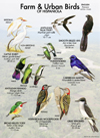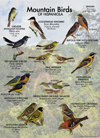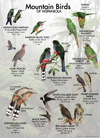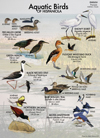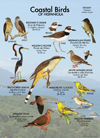Birds of Haiti
Birds belong to the zoological class of Aves. This class is divided into orders that are sub-divided into families, genera, species and occasionally sub-species and races. There are 23 orders of birds in Haiti representing over 300 species, including those that occasionally visit the island and are considered vagrants. The birds of Haiti can also be classified according to the life zone where you would likely find them. The following is an introduction to the birds of Haiti by life zone.
These birds have adapted well with humans and are found where people have built their farms and urban areas. We find these birds in the courtyards, gardens, fields, public spaces, on rooftops and along roadsides. Since so much of the Haitian landscape has been modified, these birds are the most common and easily observed.
Mountains cover three quarters of the land area in Haiti, thus these birds are quite numerous. The areas where they are most likely found are in forested areas such as national parks, coffee-growing regions, fruit orchards, home gardens and patches of natural forest. Many of the species are migratory and are found in Haiti only part of the year, either as winter residents or in transit to other islands in the Caribbean.
These birds are found in and around fresh and brackish wetlands, lakes, lagoons and marshes. They are adapted to such environments with specialized feet to move in water and beaks to capture fish, crustaceans, invertebrates and mollusks as well as eating aquatic plants. The wetlands provide shelter and these birds often roost together in rookeries that are important to the health of these aquatic ecosystems.
A diversity of habitats occur where the ocean meets the land, including mangroves, beaches and rocky shorelines. The birds of these areas are uniquely adapted to the marine environment and often much larger than birds found in the interior of the island. The calls and flight patterns commonly distinguish the species.
These areas of Haiti occur in the lowlands that are leeward of the mountains that block the prevailing winds and rains. The birds often occur in large flocks that are nourished by the abundant reptiles, grasses and herbs that are found in the dry zones. As in other areas, these birds aid in the control of insect pests and disperse the seed of many valuable tree, shrub and herbaceous species.
Special Birds
There are many Haitian birds that are special in their own right. Thirty one birds found in Haiti are island endemics – they are found only on Hispaniola. Many other species are migratory and spend only part of the year on the island, especially during the northern winter months (November – March). Unfortunately, an increasing number of birds are threatened and occur on the IUCN Red List. There are 5 Critically Endangered birds, 7 Endangered birds and 25 Threatened birds according to Latta et al. (2006). Almost half of these are endemic.
Four birds are presented as examples of the bird diversity found in Haiti.
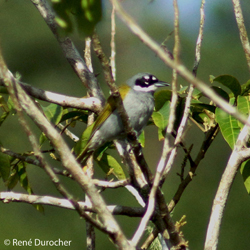 Grey-crowned Palm Tanager (Phaenicophilus poliocephalus) is the only bird that is endemic to Haiti, occurring in the southern peninsula west of the Jacmel-Fauché Depression and on the three satellite islands – La Gonâve, the Cayemites and Ile-à-Vache. The common name for the species – Quatre-yeux or “four eyes” – is evident by the white spots near its eyes. Three subspecies are recognized: one on La Gonâve, one on Ile-à-Vache and one on the peninsula and the Cayemites. The range of a closely related species, the Black-crowned Palm Tanager (Phaenicophilus palmarum) occupies the rest of Hispaniola to the north and east of the Jacmel-Fauche Depression.
Grey-crowned Palm Tanager (Phaenicophilus poliocephalus) is the only bird that is endemic to Haiti, occurring in the southern peninsula west of the Jacmel-Fauché Depression and on the three satellite islands – La Gonâve, the Cayemites and Ile-à-Vache. The common name for the species – Quatre-yeux or “four eyes” – is evident by the white spots near its eyes. Three subspecies are recognized: one on La Gonâve, one on Ile-à-Vache and one on the peninsula and the Cayemites. The range of a closely related species, the Black-crowned Palm Tanager (Phaenicophilus palmarum) occupies the rest of Hispaniola to the north and east of the Jacmel-Fauche Depression.
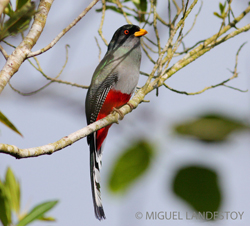 The beautiful Hispaniolan Trogan (Priotelus rosegaster) is the national bird of Haiti. Its populations are threatened since the undisturbed forests that it prefers are disappearing in Haiti. It is found mostly in the upper elevations of the mountain ranges and always in trees and shrubs. The common name – Caleçon Rouge – refers to the red belly that resembles red shorts.
The beautiful Hispaniolan Trogan (Priotelus rosegaster) is the national bird of Haiti. Its populations are threatened since the undisturbed forests that it prefers are disappearing in Haiti. It is found mostly in the upper elevations of the mountain ranges and always in trees and shrubs. The common name – Caleçon Rouge – refers to the red belly that resembles red shorts.
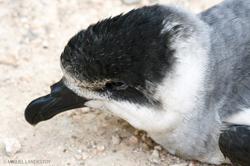 Haiti is the most important nesting area of the Black-capped Petrel (Pterodroma hasitata), a critically endangerd bird. It spends most of its time at sea, but during the winter months it comes ashore during the evenings to build its nests in the high cliffs of the Massif de la Selle and Massif de la Hotte. Fledglings leave their nest during the early summer months. Habitat loss and predation by humans and introduced mammals are the most serious threats to the species’ survival.
Haiti is the most important nesting area of the Black-capped Petrel (Pterodroma hasitata), a critically endangerd bird. It spends most of its time at sea, but during the winter months it comes ashore during the evenings to build its nests in the high cliffs of the Massif de la Selle and Massif de la Hotte. Fledglings leave their nest during the early summer months. Habitat loss and predation by humans and introduced mammals are the most serious threats to the species’ survival.
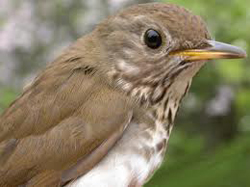 The threatened Bicknell’s Thrush (Catharus bicknelli) is a migratory bird that resides in Haiti during the winter months (November – April) and breeds during the summer in eastern Canada and northeastern US. Its winter habitat of moist broadleaf cloud forest is under severe threat in Haiti being converted to gardens and pastures and cut for charcoal and fuelwood.
The threatened Bicknell’s Thrush (Catharus bicknelli) is a migratory bird that resides in Haiti during the winter months (November – April) and breeds during the summer in eastern Canada and northeastern US. Its winter habitat of moist broadleaf cloud forest is under severe threat in Haiti being converted to gardens and pastures and cut for charcoal and fuelwood.
Reference:
Latta, S., C. Rimmer, A. Keith, J. Wiley, H. Raffaele, K. McFarland & E. Fernandez. 2006. Birds of the Dominican Republic and Haiti. Princeton University Press, Princeton & Oxford. 258 pp.



